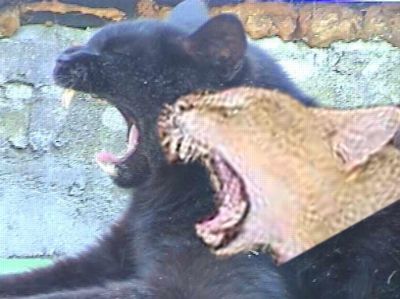
Report from Allan Paul
Is the Moray puma an African Golden cat?
By Allan Paul, 20 th September 2002
 A colleague of mine told me the other day that he saw a very large cat while returning home to Banff from one of our shifts.
A colleague of mine told me the other day that he saw a very large cat while returning home to Banff from one of our shifts.
He is a very reliable, down to earth guy, not prone to making excited claims, has spent most of his life in a fishing and farming community, and is a trained observer. I'll get more details from him the next time I see him at work.
The area between Fochabers, the Bins of Cullen and the coast has a history of big cat sightings...several years ago I spoke to a farmer's wife from Keith, who had phoned me for a hay-making weather forecast, and I asked her if she had seen any big cats around. She hadn't, but a lot of her lambs had been mysteriously eaten, describing a typical cat meal. Some friends of hers had seen a puma-like animal between Fochabers and the coast.
The sighting was on a road that links Keith with Banff, around 21.45 in the evening, 20 th September. The headlights caught the animal as it ran across the road in front of him, and stopped by the side of the road. He got a good look at it, even in the poor light, as it sat watching him unconcernedly. He said it was a uniform colour (khaki was how he described it!), looked like a domestic cat, except much bigger, almost around the size of an Alsatian, and with bigger ears than a domestic, even scaled up.
 I showed him some images of a African Golden Cat, and he said it could have been the cat he saw. He has spoken to local farmers who have said 'Oh there are lot's of them around here...so what?'.
I showed him some images of a African Golden Cat, and he said it could have been the cat he saw. He has spoken to local farmers who have said 'Oh there are lot's of them around here...so what?'.
It has always puzzled me why witnesses have described puma and panther, and then equated the size to a labrador dog...perhaps Felis aurata is the answer, in both it's usual and melanistic form.
Allan Paul

Its interesting how that response seems so similar to
the ones I get whenever I talk wih local farmers or
hunters concerning cats. Their reply is that they have
never seen a bobcat, but have seen quite a number of
"wildcats"or "swamp-cats". According to them, these
cats are much larger than a domestic, most often tan,
but sometimes black, spotted or striped. In most
cases,
these are the older farmers who saw these cats more
frequently in the 1940's and before. A few times, I've
shown pictures of cougars which they call "mountain
lions", but definitely not the same as the swamp cat.
This so-called swamp-cat was much more common than the
bobcat and easily killed. One hunter tells me of
having
shot one around 1951. He described it as being larger
than a fox with a tan coat and a long tail. These cats
were said to be considered shy and reclusive posing
no threat to chickens or livestock, unlike the dreaded
bobcat which was considered a danger to humans and
animals. Whatever these cats are, or were, they have
never been documented as any known indigenous species.
In the foothills of Virginia where I grew up, theres
no mention of any such cat even though bobcats do
exist there. In one site devoted to cryptic felines,
there is a breif mention of the "long-tailed
Pennsylvania Wildcat".
I've attached a photo of my own Panther along with
a jungle cat which George has super-imposed. A
veterinarian in Florida told me sometime back that he
suspected Panther might have origins from this
species.
Of course his speculation was only based on a few
photographs but I think this photo shows a major
difference in the skulls. What does everyone else
think ?
Ben Willis
Interesting photo of Panther...his profile and dentition does look like
something special, unlike a domestic or Felis silvestris.
It's strange you should mention the 'swamp cat' was not considered a threat
by your local farmers...that is exactly the same thing the farmers around
Banff told my colleague, when he asked if they had seen anything. The
general impression was that these big cats seen around Banff did no harm, so
why bother them?
When you mentioned the jungle cat, I looked at my book 'Wild cats of the
world' by David Alderton, and sure enough, one image of the cat looks like
it's khaki-coloured, like Bob's description.
I seem to remember from somewhere that Felis chaus is hybridised with
domestic cats by some breeders to obtain 'Chausies', a domestic breed...it
might be another source of these animals and their hybrid offspring becoming
naturalised in the UK and USA.
Allan Paul
One thing that stands out about Jungle cats is that they were used on ships to kill rats, so there is always the possibility that they jumped ship and went wild. I'm particularly interested in the possibility of Jungle cats being a contender for some of the sightings here as I read that there is a high proportion of black jungle cats in Pakistan and Dundee had a long connection with that area due to the jute trade.
George Markie
20 th September 2002
 |
 |
 |
 |
| Return to index | Return to Scottish Big Cats | Return to Moray | Return to 2002 |